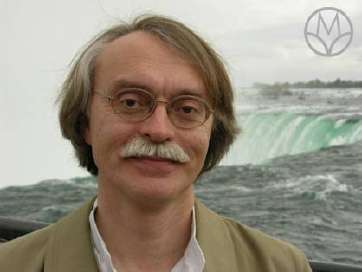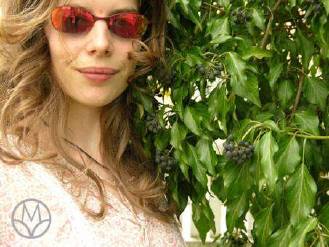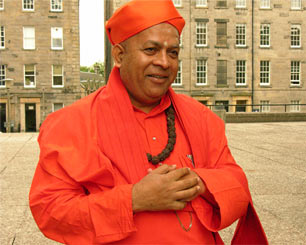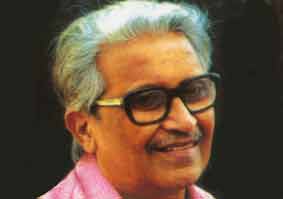


 |
Robert
J. Zydenbos
was born in Toronto, Canada and studied Indian Philosophy
and
Dravidology at the University of Utrecht (the Netherlands)
and Indian
languages and religions at the University of Heidelberg
(Germany). He
has taught at universities in Germany, India and Canada. At
present he is professor of Modern
Indology in the Ludwig-Maximilians-Universität in
München
(Munich), Germany. The main research interests of the Canadian-Dutch Indologist, philosopher and Dravidologist concern modern and classical India: thematically religion and philosophy, regionally the South Indian state of Karnataka. In particular he has occupied himself with Jainism, the Vaishnavism of Madhva, and Virashaivism. Of the numerous languages which he learnt to read and speak in the course of his life, he at present teaches only Sanskrit, Kannada and Tamil. Select bibliography: Jainism Today and its Future. Manya Verlag, München 2006. The Calf Became An Orphan. A study in contemporary Kannada fiction. Institut français de Pondichéry / École française d'Extrême-Orient, Pondicherry 1996. Moksa in Jainism, according to Umâsvâti. Fr. Steiner Verlag, Wiesbaden 1983 (Beiträge zur Südasien-Forschung, Südasien-Institut, Universität Heidelberg. Band 83). |
|
 |
Eva-Maria
Glasbrenner, born in
München, Germany, is a philosopher, scholar of
religious studies,
and Indologist. The founder of the Manya Verlag München
is at
present writing her doctoral dissertation (Anubhava. Der Begriff
der mystischen Erfahrung im Virashaivismus). Apart
from this she
works as Sanskrit tutor at the
Ludwig-Maximilians-Universität
München (Munich), Germany. Her research interests are Indian philosophy and religion, especially Hinduism, Shivaism, Tantrism and Jainism, as well as Indian art and the aesthetics of religion. Select bibliography: Götterplakate – ein Phänomen des modernen Brahmanismus. In: Hochglanzgötter. Plakate hinduistischer Gottheiten im modernen Indien. Katalog zur gleichnamigen Ausstellung. Hrsg. zus. mit Wolfgang Stein. Staatliches Museum für Völkerkunde: München 2000, S. 9-16. Tanz in der sudanesischen Bruderschaft Tariqua Burhaniya – Beschreibung einer Hadra. In: Acta Orientalia, Vol. 62/ 2001, S. 81-91. Das Geschenk als Fluch. Die Mitgiftproblematik im modernen Indien. In: Geschenkte Welten. Schätze aus der Ferne. Hrsg. von Anka Krämer de Huerta. Staatliches Museum für Völkerkunde: München 2003, S. 45-51. |
 |
Shivamurthy
Shivacharya Mahaswamiji
is one of the highest religious leaders (jagadguru, "teacher
of the world")
of the
Virashaivas or Lingayatas. Virashaivism is a
philosophically
significant Shivite religion, of which most followers
(approx.
15 millions) live in the South Indian state of Karnataka.
Religious
experience is at the centre of thinking and acting in this
special
monistic worldview. This expresses itself on the one hand
in a
fascinating metaphysical concept, that describes spirit
and matter as
aggregational states of one single reality - Shiva -, and
a unique
six-staged concept of the path to knowledge and salvation
(shatsthalasiddhanta),
that is not
found elsewhere. But this attitude also benefits
socio-political
reality: since its rise in the twelfth century, Virashaiva
ethics
rejects the caste system and discrimination against women,
and it
distinguishes itself by a special work ethic: as it is
said in the
Kannada language, kelasave
kailasa,
work
is heaven. Shivamurthy Shivacharya Mahaswamiji, descendant from a simple agricultural family, was called to occupy the high position of the Virashaivas on account of his extraordinary intelligence, his musical talent and creativity, but also for his great modesty, empathy and charismatic dignity. From his centre in Sirigere, the Sri Taralabalu Jagadguru Brihanmatha monastery, he guides his religious community and surprises not only his Indian followers and admirers with his fine balance of tradition and openness to the world. Shivamurthy Shivacharya Mahaswamiji is known not only for his large-scale educational projects (encompassing hundreds of schools and colleges) and ecological projects for the reforestation of the region that has become arid, but also for his computerized projects (such as the digitalization of the work of the most important Sanskrit grammarian, Panini, and of commentaries to this work) and for his efforts at dialogue with religions and cultures across the world. After obtaining his doctorate at Benares Hindu University, he continued his studies in the University of Vienna, the main European centre of Indian philosophical studies. As Jagadguru he chartered an airplane and travelled around the world for weeks with a large group of people from his home region - as world teacher of a great religion he wished and wishes to learn more about the world and its pluralism and to share this experience with as many as possible. Select bibliography: A Critical Study of the Suta-Samhita. A Thesis submitted to the Banaras Hindu University. Department of Sanskrit and Pali, Faculty of Arts. Banaras Hindu University, Varanasi 1976. Hoffnungen und Enttäuschungen des interreligiösen Dialogs, Sri Taralabalu Jagadguru Brihanmath, Sirigere (Indien) 1991. (Nachdruck von: Hoffnungen und Enttäuschungen des interreligiösen Dialogs, in: Dialog der Religionen, Zweimonatsschrift (Heft 1), Christian Kaiser Verlag, S. 73-82). Hindu Visions of Global Peace. Sri Taralabalu Jagadguru Brihanmath, Sirigere (Indien) 1994 (2. edition). |
 |
Shantinath
Desai (1929 - 1998) is
one of India's most prominent modern writers and was a part
of the
important Navya movement, the influential innovative
movement in
Kannada literature after India attained independence. Before
1947,
modern Indian literature was largely characterized by the
patriotism of
the independence struggle or by an escapism into romantic
dreamworlds.
After a relatively short phase of Marxist-inspired socially
critical
literature (pragativada)
that
began in the 1940s, Navya came into being: its main
characteristics are
its emphasis on the human individual and the inspiration by
European
models - especially existentialist philosophy and
psychoanalysis. Although Desai's mastery of English was excellent (and he translated the novel Bhava by his friend U.R. Anantha Murthy into English), he wrote all his own works in his South Indian mother tongue Kannada. His most important works, besides Vikshepa ("Perturbation", soon to appear in English translation in Manya Verlag), are his first novel, Mukti ("Liberation"), Bija ("The Seed"), and his posthumous novel Om Namo ("Obeisance To..."), which recently appeared in a filmed version by Girish Karnad on Indian television. Desai's oeuvre also includes short stories and essays. Shantinath Desai was professor of English in the University of Kolhapur (Maharashtra), and later he became the first president of the newly founded Kuvempu University in Shimoga (Karnataka). Vikshepa. Manya Verlag, München 2009. |